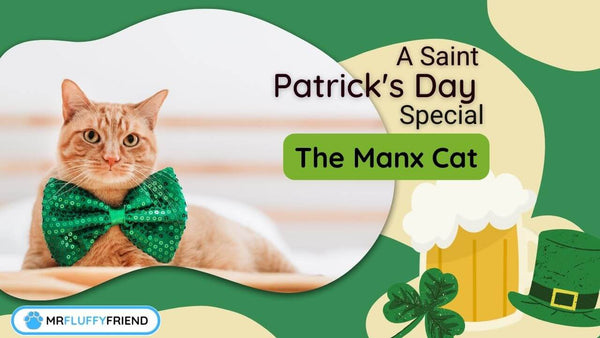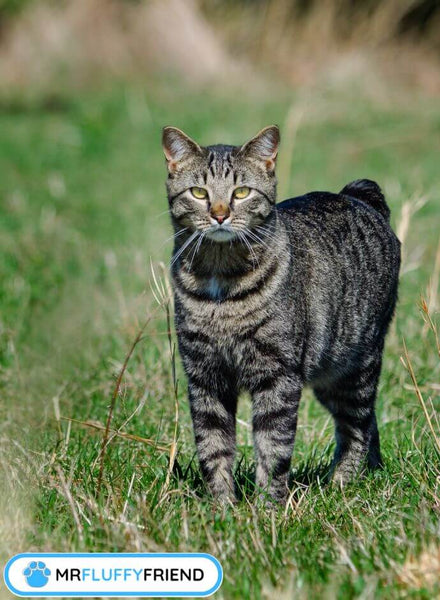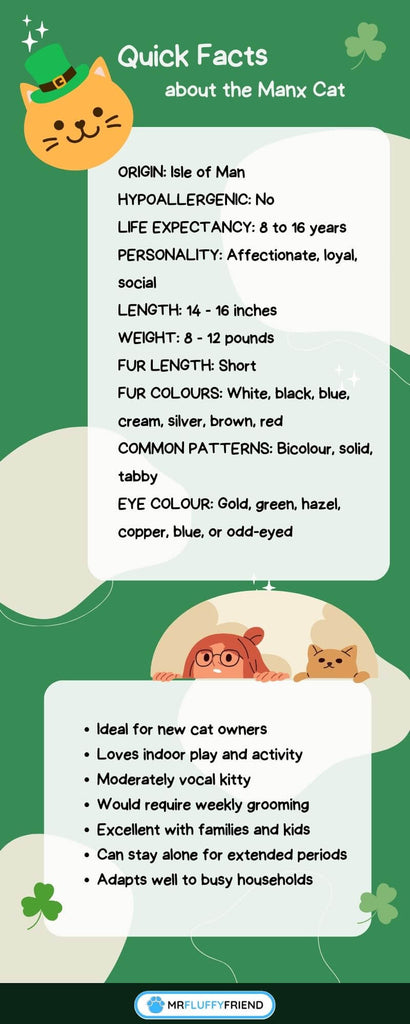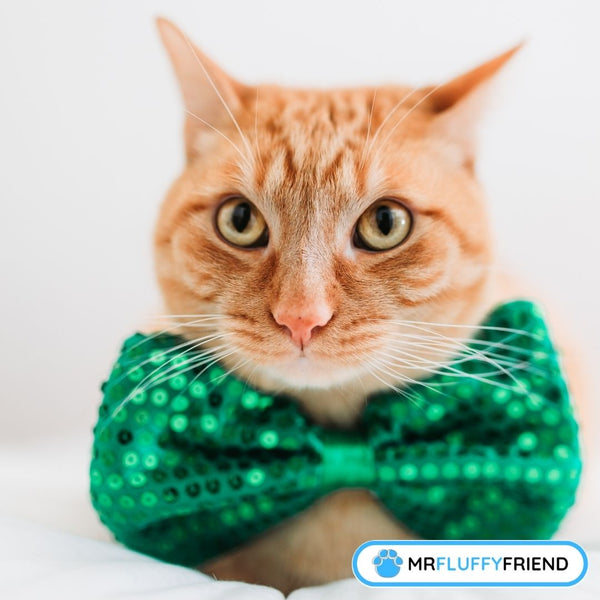What Is a Manx Cat: Facts and Information
As St. Patrick's Day draws near, festivities and celebrations are typical.
These parties are often adorned with symbols of Irish culture and folklore.
Amidst the shamrocks and leprechauns, one intriguing figure emerges—the Manx cat.
What is the Manx cat?
How are they related to St. Patrick’s Day?
Join us as we take a deep dive into this fascinating cat breed (click the links below to go to that section):
- History and Origins of the Manx Cat
- What is a Manx Cat?
- Celebrating the Manx Cat this St. Patrick’s Day

History of the Manx Cat
The history of the Manx cat is as mysterious and intriguing as the breed itself.
The Manx captured everyone’s attention through their physical traits and charming personality.
Origins of the Manx Breed

The origins of the Manx cat are shrouded in mystery.
One theory suggests a spontaneous genetic mutation on the Isle of Man, resulting in the Manx cat’s distinctive short or absent tail trait.
One popular legend says that the Manx cat was originally brought by Spanish Armada sailors shipwrecked off the coast of Ireland.
These cats then made their way to the Isle of Man, where they thrived and multiplied.
Eventually, this gave rise to the distinct tailless cats from the small island in the Irish Sea.
Another legend involves Noah’s ark.
When Noah was gathering animals, he accidentally slammed the door of the ark on the tail of the Manx cat, thus resulting in the breed’s lack of tail.
While these stories are undoubtedly steeped in myth and folklore, they add an enchanting layer to the history of the Manx cat.
Spread of the Breed to Other Regions
The tailless Manx cats gained popularity beyond their native shores.
Sailors and traders likely played a significant role in spreading the breed to other regions.
The reason for this is that Manx cats are natural hunters.
Thus, they were often kept aboard ships to control vermin populations.
Over time, these felines found their way to various parts of the world.
Related: BARF 101: Biologically Appropriate Raw Foods
What Is a Manx Cat?
Manx cats are instantly recognisable for their unique physical attributes.
Let's delve into the features and characteristics that make the Manx cat unique.

- Lack of Tail:
One of the most striking characteristics of Manx cats is their non-existent tails or short, stubby tails.
This distinctive trait is due to a genetic mutation affecting the tail vertebrae's development.
While the exact cause of this mutation is still a mystery, it's believed to have originated on the Isle of Man centuries ago.
- Variations in Tail Length:
Within the Manx cat breed, there are several variations in tail length:
- Rumpy / Rumpie: These Manx cats have no tail at all.
- Rumpy Riser: Rumpy risers have a slight bump or rise where the tail would typically be.
- Stumpy / Stumpie: Stumpies have a short tail that may extend a few vertebrae beyond the body.
- Longy / Longie / Taily / Tailie: While less common, some Manx cats may have a longer tail. It's still shorter than the tails of most other cat breeds.
- Distinctive Features:
Manx cats are also known for their round appearance (round head and round eyes).
Their hind legs are also distinct because they’re longer than their front legs.
This physical build gives them a sturdy, robust appearance and also contributes to their agility and athleticism.
Their muscular hindquarters are helpful for swift movements, making them skilled hunters.
- Temperament and Personality:
One of the hallmark traits of the Manx cat is their affectionate and loving nature.
These cats form strong bonds with their cat parents and are often described as loyal.
Their friendly disposition extends to visitors as well.
Manx cats are sociable and welcoming to guests.
They thrive on companionship.
They enjoy being part of a loving household where they receive plenty of attention and affection.
- Intelligence and Adaptability:
Manx cats are not only affectionate but also highly intelligent and adaptable.
They’re fast learners and love engaging in interactive play and puzzle-solving activities.
Their intelligence makes it easy for them to learn tricks and commands.
Also, Manx cats can adapt to a variety of living situations.
Whether in a bustling household with children and other pets or in a quieter environment with a single owner, the Manx is an easygoing cat.
Potential Challenges

Like any breed, the Manx may exhibit certain challenges that owners should know.
One potential issue is territorial behaviour, particularly among unneutered males.
Like many cats, Manx may display territorial tendencies.
They would mark or display aggression toward other animals if they feel their territory is threatened.
Still, early socialisation and proper training can help mitigate these behaviours.
Manx cats can have spinal cord issues.
A shortened tail or the absence of a tail can be associated with spina bifida or sacral agenesis.
Additionally, Manx cats may suffer from Manx Syndrome.
This condition is a collection of health issues that can affect cats with the tailless gene.
One of the primary concerns of Manx Syndrome is the incomplete development of the spine.
This can lead to spinal deformities, neurological issues, and bowel and bladder incontinence.
Related: How To Prepare for a New Family Member
Manx Cats and St. Patrick's Day
For cat owners, celebrating St. Patrick's Day with their Manx cat can be a fun and festive occasion.
Add green toys or accessories to your cat's playtime, or treat them to a special green-themed meal or snack.
Additionally, spend quality time with your Manx cat.
They would love cuddling on the couch or engaging in interactive play.
By embracing the special bond between Manx cats and Irish culture, St. Patrick's Day becomes a celebration of heritage.
It’s also an opportunity to honour our beloved feline companions that bring joy and light into our lives.
Related: Celebrate St. Patrick's Day with Your Pet

Conclusion
This St. Patrick’s Day, may we continue to cherish and celebrate the enduring charm of Manx cats.
From everyone at MrFluffyFriend, happy St. Patrick's Day to you and your fur babies!
Looking for some products that could help you out?
Check out our Online Shop!
Here are some useful products in relation to this blog post:
MrFluffyFriend - Carrot Snuffle Toy
MrFluffyFriend - Anxiety Relieving Pet Bed


I adopted a 3 month old Manx mix with Maine Coon and any advice on how to train my male kitten to stop biting and scratching so much ? I tried using water bottle but he doesn’t care about the water, any other suggestions?
———
MrFluffyFriend™ replied:
Hi Cheryl thank you for your comment, as your new kitty is still young, it’s possible that he’s still teething. In any case, try offering him toys he can nibble on. Add his favorite food close to this toy and let’s see how that goes. Hope you lots of luck! On Sun, 29 Dec, 2024 at 9:56 PM , Sunny <sunny@comment.sunnysideapps.com> wrote:
Ny manx just passed and was so connected to me. He was an explorer. He walked with me a dogs every might and sometimes cut us off on the way back .he would call out if we hot too far ahead.
At the end I kept him on a harness. He was a loving cat and snuggled with 3s of my dogs too. Best cat I ever had and I took him so he would not be hurt from a strangers neighbor. He recognized my voice and would call out. I had him replaced to fix the incontinence and retaining g urine e.
He was tge best and I dearly miss him as do my dogs and other cats. I would take a rescue manx in a heartbeat!
———
MrFluffyFriend™ replied:
Hi Diane,
So sorry to hear about your precious Manx. Thank you for sharing his lovely story.